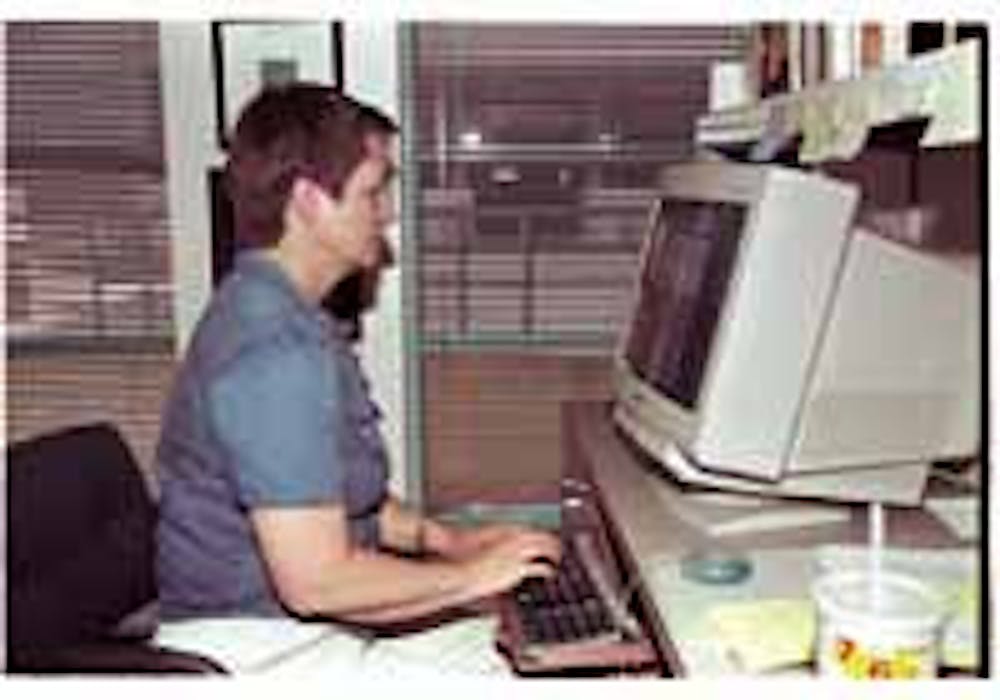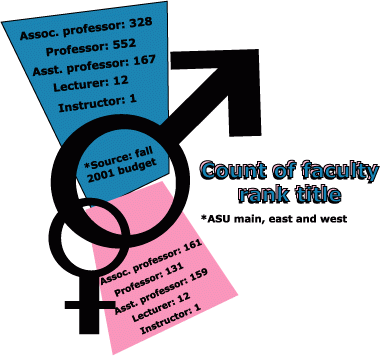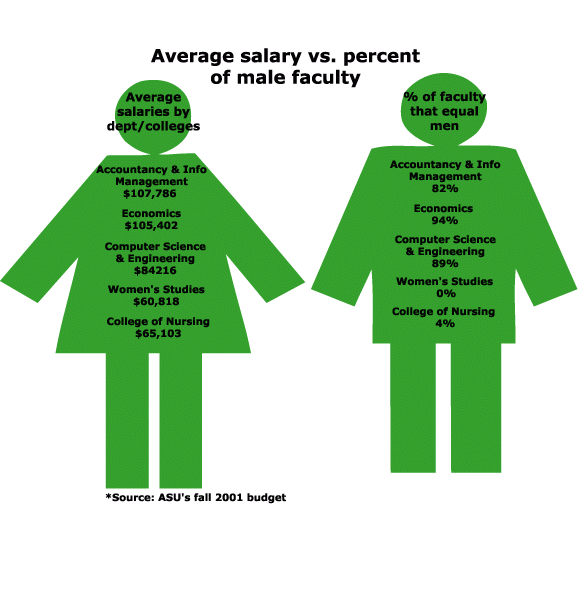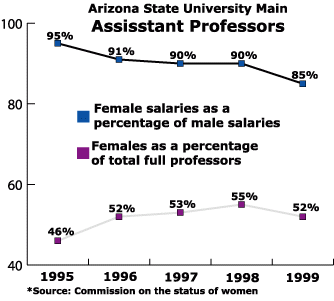Michael Hitt has been teaching the principles of business for 28 years.
Ann Hibner Koblitz has been teaching the progression of women's studies for 20 years.
Hitt and Koblitz began their teaching careers outside of Arizona, forging names for themselves in their respective fields. They say they love working with students and the opportunity to conduct research. Both are full professors at ASU.
The difference?
He makes $190,000.
She makes $60,000.
The salary gap between male-dominated and female-dominated academic departments is widening at an alarming rate, ASU's Commission on the Status of Women will report this week at the Arizona Board of Regents meeting in Flagstaff.
At ASU in 1995, the average salary of a female assistant professor was 95 percent of the average male assistant's salary. In 2000, that figure dropped drastically to 85 percent.
Men and women within a department are being hired at comparable base salaries, said Carolyn Forbes, academic liaison for the commission. The problem is that base salaries vary dramatically between departments.
"It leads one to question: 'Is there something about having more women in the field that ends up leading to lower salaries?'" Forbes said. "There has been an accelerating salary difference emerging between, say, business, science and engineering fields, and humanities and social sciences. This is attributed to market forces."
Most people agree the outside market drives unbalanced pay among university departments, especially business and humanities. A businessman with a doctorate, who can easily draw a six-figure salary in the private sector, is unlikely to take a teaching position for much less.
But a growing group of staff and faculty say the market is an easy scapegoat, and they say a more pervasive factor is at work — gender bias.
"Business and engineering salary increases have been accelerated, and interesting enough, those particular fields also happen to be fields in which you have an overrepresentation of males and an underrepresentation of females," Forbes said. "Fields in which women have made substantial advances have actually seen salary increases remain flat or minimal."
Koblitz said the discrepancy in pay among the departments is often biased and unwarranted.
"The training and level of expertise is the same, and in many cases there is a higher level of expertise in women's studies than in business," she said. "Usually what we're told is so-called market forces dictate the difference in our salaries. Somehow it seems as though fields in which there is a high percentage of women have not been able to attract a higher salary."
Indeed, salary data from fall 2001 reveal uneven pay between male-dominated and female-dominated fields. In the department of accountancy, where 82 percent of the faculty is male, the average salary is $108,000. In the College of Education, where 66 percent of the faculty is female, the average salary is $54,000.
But Hitt said the salary discrepancy boils down to what students learn in basic economic courses — the principle of supply and demand.
"It's easier for me to get a job in the external market; you go out into (the field of) business and they pay different salaries than other fields," he said. "Similarly, the students who graduate from here and take jobs in different fields won't get the same pay. It's not because one is a better person or has more skills."
Although discrepancies between men and women cannot be ruled out, Hitt said he'd like to believe that gender does not play a role in his pay.
"Maybe I'm Pollyannaish," he said. "I'm a male and could be biased, but I sincerely hope (gender bias) is not the case."
A history of disparity
ASU, along with NAU and UA, has long been entrenched in a battle against unfair salaries, said Kay McKay, president of the Arizona Board of Regents. Twelve years ago, the board commissioned a report on salary equity at the state universities and found disturbing results when they compared men's pay against women's.
The glaring glass ceiling prompted ABOR to establish a Commission on the Status of Women at each university. The groups were charged with monitoring women's issues on campus, including salaries, and reporting back to the board periodically.
"The inequity is real," McKay said. "I will never deny that. It's going to take time to get salaries equalized because men were there first, and until they retire there will be uneven salaries."
McKay added that she is encouraged by recent figures. A 10-year follow-up report by the commission in 2001 revealed slow but significant progress in gender equality within departments, Forbes said.
Not only had departments begun to offer standard salaries for new employees, the number of women professors was climbing. In 1991, women comprised 23 percent of the faculty, and in 2001, they accounted for 40 percent.
Today, more than half of new hires are women, Forbes said.
"There's still a lot of work to do," Forbes said, "but at ASU, in terms of base salary for male and female faculty within a particular department, parity has been substantially achieved."
The glass ceiling
In some departments, there appears to be no salary inequity. For example, the only two women professors of physics and astronomy earn $95,000 and $98,000 in a department where $85,000 is the average salary.
But in other departments, it's a persistent problem.
Leslie Van Duzer, an associate professor of architecture, graduated from the University of California at Berkeley with a master's degree in architecture and has taught at the University of Michigan, the Helsinki Technical University and ASU. After 12 years of teaching, five at ASU, she earns $53,000 a year.
Van Duzer said she's had a positive experience on staff — she enjoys her students and colleagues. But when asked if there is a glass ceiling at ASU, she paused.
"I would have said no except just recently a female colleague told me she looked up our department's salaries and the women's salaries are disproportionately lower than the men's."
In the School of Architecture last semester, the average salary for a male associate professor was $58,000 while that of a female associate was $53,000.
Although sporadic reports tend to shed light on the salary issue, information about faculty salaries is available year round. Because the University is a public institution, its budget is public record. Hayden Library keeps bound volumes of faculty and staff salaries, which can be viewed for two hours at a time.
Most professors don't discuss salaries, Van Duzer said.
"Anyone can go to the library, ask for the state budget book and see for themselves," she said. "Unless they're really curious, though, most professors don't."
Setting the pays
Administrators are all too aware of the fight against salary inequity. They're responsible for setting and equalizing pay in their departments. Architecture Dean John Meunier said it's a responsibility he doesn't take lightly.
"We have tried very, very hard to ensure inequity is not a problem," he said. "We keep quite careful tabs on equity issues and have made adjustment in the past."
When the college receives a new pool of funds for salary increases, Meunier said he and the salary committee use three criteria to determine who will get the money: merit, market and equity.
Merit is a teacher's overall value to a college, market is a measure of that person's market value on a national level and equity is ensuring that women and minorities are being fairly paid, Meunier said.
Similarly, the College of Engineering sets aside funds to address equity issues, said Ben Huey, associate dean for planning and administration.
Only four of the 37 computer science and engineering teachers in the fall were women, according to the university budget. The average man teaching in the department makes $86,000 while the average woman makes $70,000 annually.
But Huey said he believes salary equity is not a problem in his department.
"There used to be a problem with discrepancies, but we pretty comprehensively addressed equity issues several years ago, although there are some people who may not agree with that," he said. "My sense is that the dean and chairs have done extraordinarily well in paying attention to that, and they continue to pay attention."
While most faculty members are now hired at fair rates within a department, the commission reports, it is difficult to fix problems that occurred long before there was an equity initiative.
"We're trying to make up for years of unequal pay," Meunier explained. "There are men who have been here a long time, whose salaries were set when inequity was a problem. But you can't just lower their pay now to make it even."
What's to blame?
Without lowering men's pay, inequity issues must be solved by increasing the salaries of underpaid women — a difficult task when state funding is devastatingly low. In fact, the recent state budget crisis could halt the equity initiative in its tracks, said Kathleen Church, ASU vice provost.
"We are way below our peer institutions with all salaries, which is making it difficult to compete for and retain faculty," she said. "Arizona has not been a good state for public education. You have to pay for what you get, and with a fiscally conservative Legislature, things like (faculty) retention and equity suffer."
In a competitive economy, departments are forced to use the bulk of their budget to attract new faculty. The design and business departments both raised their incoming rate this year by $5,000 to compete with other universities.
In the race to attract young talents fresh out of doctoral programs, established faculty are often overlooked, Huey said. While incoming faculty are being paid competitive base salaries, existing faculty are not receiving competitive raises.
Salary inequity has been a problem during good economic times as well as bad, Koblitz said. The economy and market forces aside, gender bias and factors in women's lives affect their salary and ability to move forward in a career.
Koblitz said she has noticed a trend of her female colleagues being stuck at the associate professor level. Associates have tenure, meaning they've established themselves nationally and completed a rigorous application process. But women have a hard time reaching the next level — full professor — which requires international recognition and an even more grueling application.
There are a relatively even number of men and women at the entry-level assistant professor rank: 159 women and 167 men.
But higher on the totem pole, the disparity grows. At the associate professor level, there are 161 women and 328 men. Only 131 women are full professors, compared to 552 men. And with a higher rank comes higher pay.
"It's a lot more complicated than just a glass ceiling," Koblitz said. "The percentage of women who are full professors is not as high as it should be. A significant number of women are stalled at associate professor. There are a lot of women whose promotion to full professor has been delayed for a variety of reasons."
One reason is too many responsibilities and not enough time, Van Duzer said. Women today are often expected to juggle families, careers and volunteer projects, which leaves little time to apply for a promotion.
"Women tend to volunteer for or get asked to do things on top of their teaching load," said Van Duzer, adding this has been a topic of discussion at Faculty Women's Association meetings. "We're trained to be good girls, to put other people first. This can take away from time for research and promotions.
"It's hard feeling you have the right to focus on yourself and your work, and fighting your own mind. You have to learn to say no sometimes, even when it goes against the grain (of what you've been taught)."
For Linda Nelson Johnson, associate director of the School of Design, the explanation for uneven salaries is simple.
"It goes back to history — women have never fully recovered from that," she said. "I do agree that the distance (in pay) is lessening, but it's still out there."
Searching for a solution
With salary problems improving inside departments but growing among them, ASU is faced with more questions than answers about how to achieve equity, Forbes said. But asking questions is a crucial first step, she added.
"We're here to raise the questions to keep the issues on the table, to keep forcing people to think about it," she said of the commission. "It's really easy not to think of it if you're not forced to think of what world looks like from another perspective."
The next phase for the ASU group is to study the equity of non-monetary compensation, such as research equipment and class load. In the mean time, Forbes said, administrators and regents will have to decide if ASU should be a mirror for market forces or a model for society.
"Fortunately, we've had some really, really visionary leadership at the top who see these issues as fundamental," she added.
The Board of Regents anxiously awaits the commission's progress report, McKay said. However, she's not sure how much can be done.
"You're kind of damned if do and damned if don't," she said. "If the University paid everyone the same thing across the board, it would create some real problems. It would be fair, but it would create other problems."
It's a conundrum that Van Duzer refers to as "one of life's injustices."
"We all work equally hard, so is it fair? Absolutely not," she said. "While our salaries mirror the salaries of the real world, we all receive salaries from the state."
The issue of cross-departmental salary equity is seeping into the national discourse, Koblitz said, and she hopes the issue will infiltrate the University's salary debate as well.
Hitt said he is encouraged about the status of women on campus. In the classes he teaches, he has seen a dramatic rise in the number of women students. Undergraduate business students are split 50-50, he said, and there are more women than men in ASU's graduate business program.
More women are being hired onto the faculty and are being paid the same entry salary as incoming men, Hitt added. However, he said most professors don't become teachers because of the pay.
"I left a high-paying job to become a teacher and was paid very little at first," he said. "Money is not the primary motive. I love teaching and interacting with my students. And I love the opportunity to do research.
"But I duly feel for friends and colleagues where the markets are not nearly as strong. ... I'm fortunate I'm in business."
Reach the reporter at stephanie.paterik@asu.edu.







